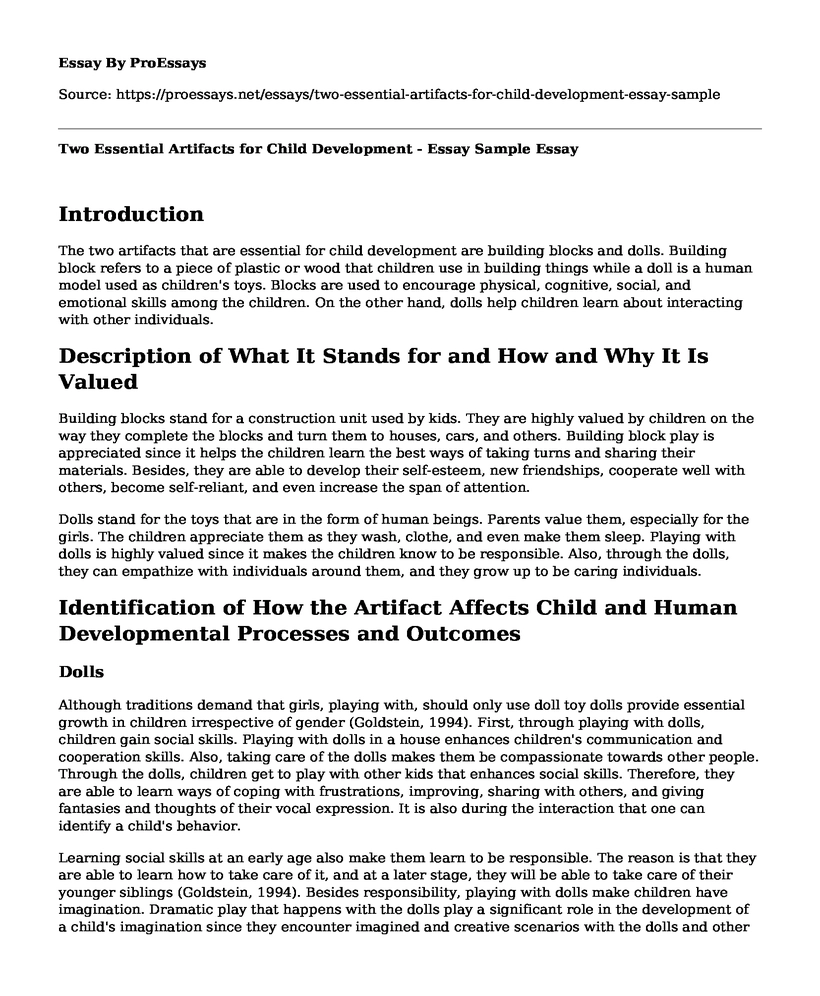Introduction
The two artifacts that are essential for child development are building blocks and dolls. Building block refers to a piece of plastic or wood that children use in building things while a doll is a human model used as children's toys. Blocks are used to encourage physical, cognitive, social, and emotional skills among the children. On the other hand, dolls help children learn about interacting with other individuals.
Description of What It Stands for and How and Why It Is Valued
Building blocks stand for a construction unit used by kids. They are highly valued by children on the way they complete the blocks and turn them to houses, cars, and others. Building block play is appreciated since it helps the children learn the best ways of taking turns and sharing their materials. Besides, they are able to develop their self-esteem, new friendships, cooperate well with others, become self-reliant, and even increase the span of attention.
Dolls stand for the toys that are in the form of human beings. Parents value them, especially for the girls. The children appreciate them as they wash, clothe, and even make them sleep. Playing with dolls is highly valued since it makes the children know to be responsible. Also, through the dolls, they can empathize with individuals around them, and they grow up to be caring individuals.
Identification of How the Artifact Affects Child and Human Developmental Processes and Outcomes
Dolls
Although traditions demand that girls, playing with, should only use doll toy dolls provide essential growth in children irrespective of gender (Goldstein, 1994). First, through playing with dolls, children gain social skills. Playing with dolls in a house enhances children's communication and cooperation skills. Also, taking care of the dolls makes them be compassionate towards other people. Through the dolls, children get to play with other kids that enhances social skills. Therefore, they are able to learn ways of coping with frustrations, improving, sharing with others, and giving fantasies and thoughts of their vocal expression. It is also during the interaction that one can identify a child's behavior.
Learning social skills at an early age also make them learn to be responsible. The reason is that they are able to learn how to take care of it, and at a later stage, they will be able to take care of their younger siblings (Goldstein, 1994). Besides responsibility, playing with dolls make children have imagination. Dramatic play that happens with the dolls play a significant role in the development of a child's imagination since they encounter imagined and creative scenarios with the dolls and other children. As children play with dolls, they run to unique and new situations in their games. Therefore, communicating among them strengthens their vocabulary while filling it with real language. Early childhood educators argue that doll toys help in a child's brain development by stimulating a sense of touch of a baby, hearing, and sight as it develops their dexterity (Goldstein, 1994).
Building Blocks
Children of both genders can play with blocks, and blocks help them to improve their math skills, develop vocabularies, and teach them concerning geometry, balance, and gravity (VanderVen, 2008). Also, as they build different structures, they learn the way to describe position, shapes, sizes, and colors. Concerning math, playing blocks makes children learn about different things, including space, patterns, area, adding, negative spaces, and operations. For vocabulary, block playing makes children increase their understanding of sentence structure, balance, and labeling.
Building blocks also enhances the creativity of children as they grow. The reason is that block play has limitless possibilities, and while growing, they are able to establish creative ways of building with blocks (VanderVen, 2008). For toddlers, it makes them have more muscle control and improve their thinking ability. Block play also enhances the physical development of a child. It is because block play enhances fine and gross motor skills at an early age, and children can learn to perform activities like putting on clothes, writing, and tying shoelaces.
Besides dolls, block play also enhances social development. Typically, every individual strives to be accepted in society. Unfortunately, the individual behaviors of humans determine their place in the social structure, which is around them (VanderVen, 2008). It is only easy to adjust in a specific social circle if one learns the social behavior basics during childhood, and building blocks serves the purpose. It is because while children play with the blocks in a group, they help, cooperate, share, and communicate with each other. Through this, they are able to create a social bond among them and improves their understanding and the importance of being responsible towards other people.
Conclusion
Both building blocks and dolls are essential for the development of a child. Through the two objects or toys, children are able to learn motor, language, social skills, problem-solving, and to be creative when handling issues. Some of the methods that can be used in learning about child development include cross-sectional and longitudinal studies.
References
Goldstein, J. H. (1994). Toys, play, and child development. Cambridge: Cambridge University Press.
VanderVen, K. (2008). Promoting positive development in early childhood: Building blocks for a successful start. New York, NY: Springer.
Cite this page
Two Essential Artifacts for Child Development - Essay Sample. (2023, Apr 21). Retrieved from https://proessays.net/essays/two-essential-artifacts-for-child-development-essay-sample
If you are the original author of this essay and no longer wish to have it published on the ProEssays website, please click below to request its removal:
- Teaching Methods for English as a Second Language Students
- If You Had Three Wishes What Would They Be Essay
- Classical Concert in High School Report
- Strategies in Teaching Content Area Learning, Vocabulary, and Math
- Mind Your Faith Book Review Paper Example
- Essay Example on Childhood Conduct Disorder: Understanding Repetitive Antisocial Behaviors
- Essay Sample on Children & Police







